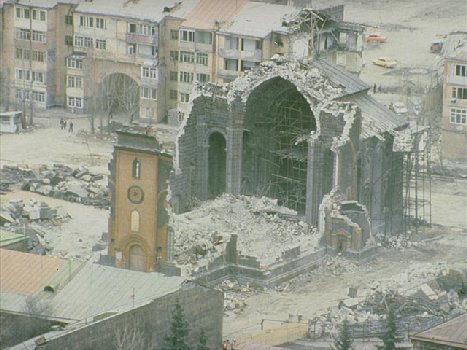| Earthquakes |
| Earthquakes are caused by the relief of stress
built up along faults in the rocks of the Earth's crust. A fault may produce
frequent, small slips, or may store up energy like an elastic band until
a large movement occurs. Waves of compression travel out from the location
of the movement (the epicentre), usually some way underground. When these
body waves reach the surface, surface waves result, and it is these slower
moving disturbances which cause most destruction.
The surface expression of the San Andreas Fault in southern California.
A magnitude 6.8 earthquake hit Armenia in December 1988. The worst earthquake of the twentieth century happened near the city of T'ang Shan in China in 1976, measuring 7.8 on the Richter scale and causing 240,000 deaths. Although most quakes are associated with the boundaries of the tectonic plates, they can also occur in the interior of the continents, such as happened at Latur, India in 1993, when a 6.1 magnitude quake killed 11,000.
More than 5,000 people died when a quake hit the Japanese city of Kobe in 1995.
Collapsed buildings in the Marina district of San Francisco resulting from the Lomo Prieta earthquake of 1989. Buildings whose foundations are not anchored in the bedrock are most vulnerable to earthquake damage, since looser soil material is more easily disturbed by the surface waves. Loose, wet ground can "liquefy" during violent shaking, losing all its structural strength. This adds to the risk in the Marina district of San Francisco, which is reclaimed from the waters of San Francisco Bay and sits above the San Andreas Fault. Steep slopes are also vulnerable, where quakes can trigger landslides. Fire, a secondary effect of many quakes in urban areas, caused over 90% of the damage in San Francisco in 1906 and Tokyo in 1923.
Elevated highway sections toppled during the San Fernando earthquake of 1971.
This Landsat image shows a burning oil refinery in northern Turkey, damaged by an earthquake in August 1999. |





